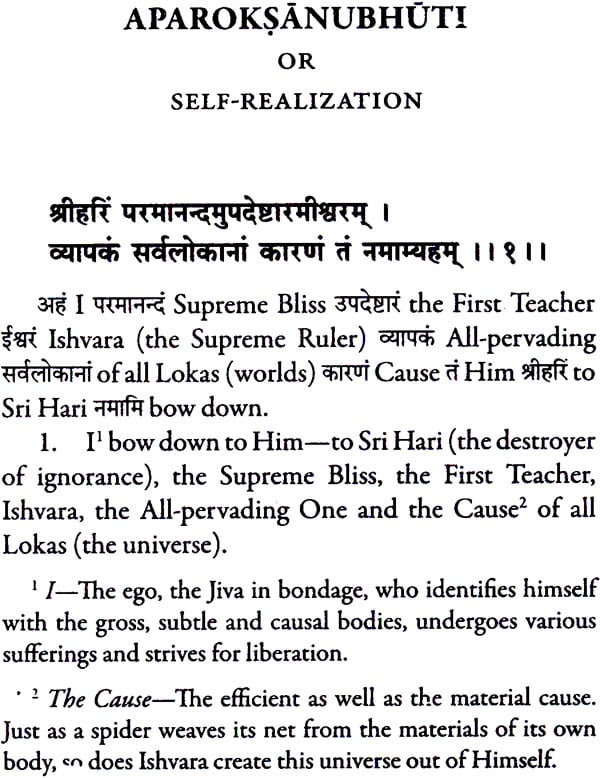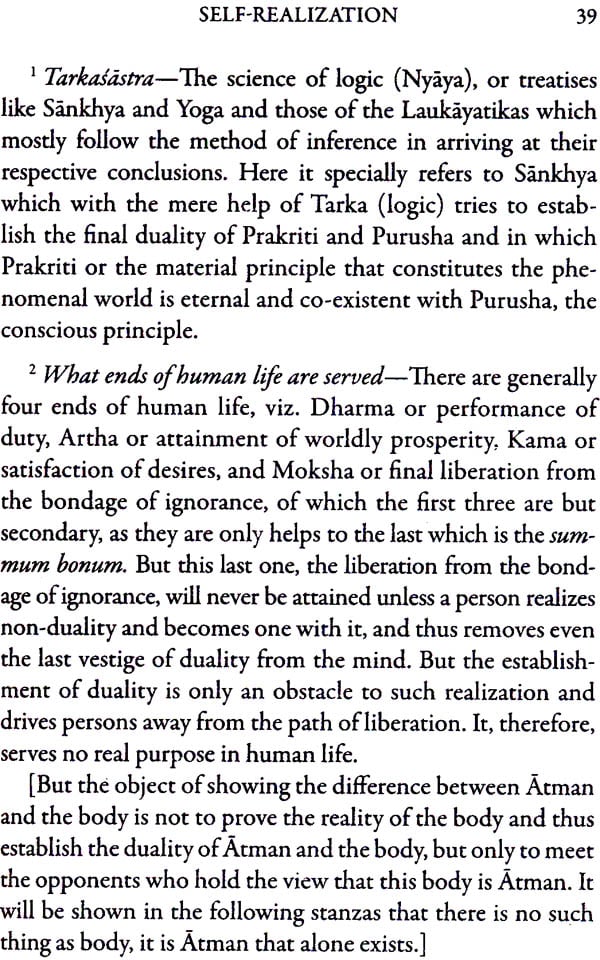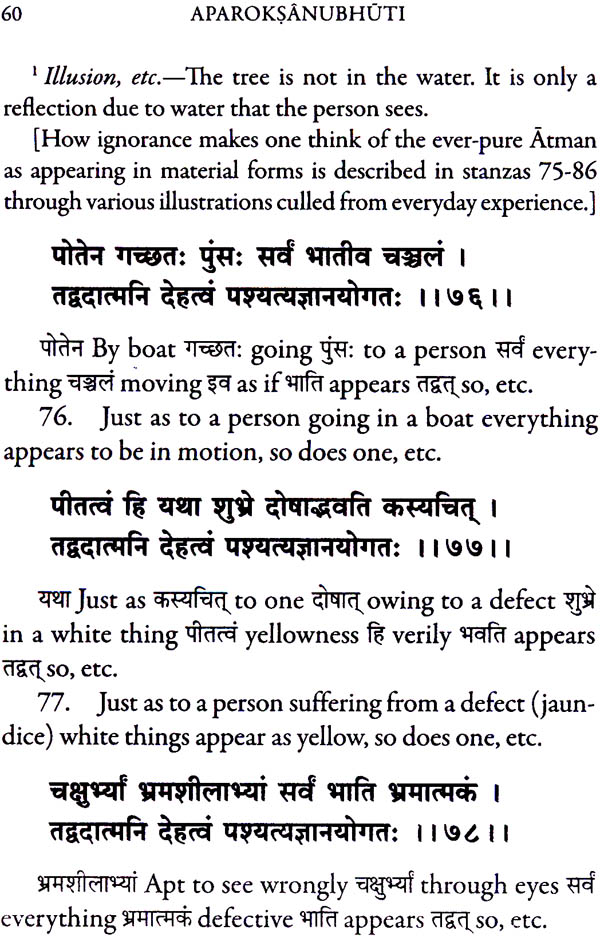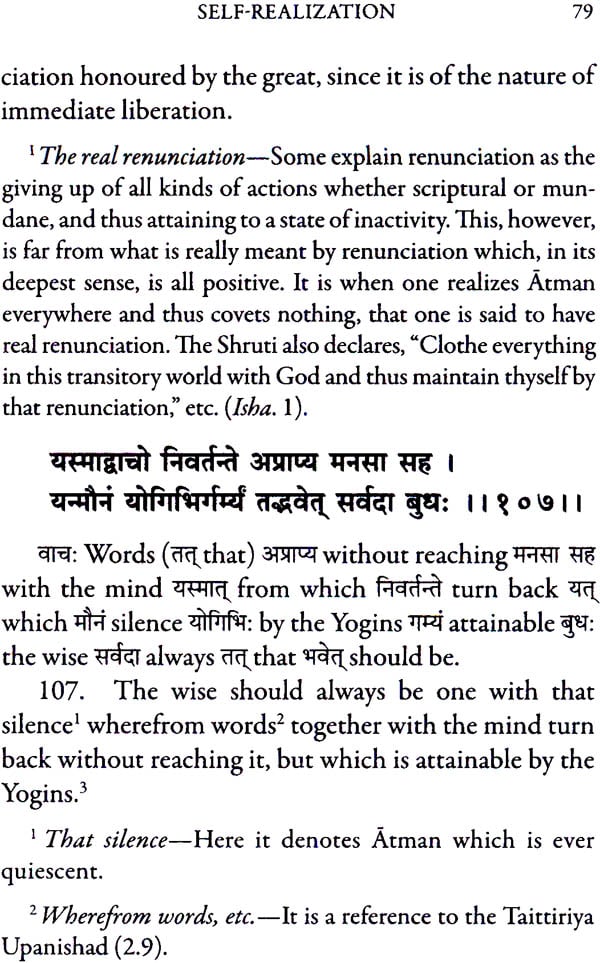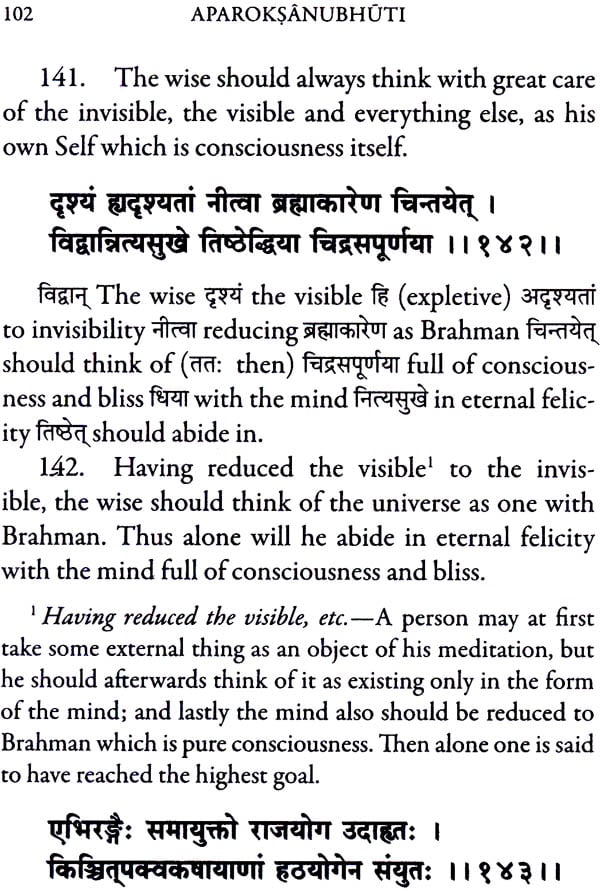
Aparokshanubhuti or Self-Realization of Sri Sankaracharya (Shankaracharya)
Book Specification
| Item Code: | IDF820 |
| Author: | Swami Vimuktananda |
| Publisher: | ADVAITA ASHRAM KOLKATA |
| Language: | Text, with word-for-word Translation, English Rendering and Comments |
| Edition: | 2014 |
| ISBN: | 9788175051072 |
| Pages: | 78 |
| Cover: | Paperback |
| Other Details | 7.0" X 4.7" |
| Weight | 70 gm |
Book Description
About the Book:
It is one of the most important works of Shankaracharya on Advaita philosophy. The central theme of the book is the identity of the individual self and Universal self. This identity is realized through the removal of the ignorance that hides the truth, by the light of Vichara or enquiry alone. To those who have neither the time nor the opportunity to go through the classical works of Shankara, this book will be an invaluable guide in their quest after spiritual truth.
Such treatises as aim at serving as introductions to a more advanced study of a system of philosophy are generally known as 'Prakarana Granthas' Besides giving an outline of the system, each of them emphasizes some one or other of the main features. Aparoksanubbuti is one such little manual, which, while presenting a brief description of Vedanta, deals specially with that aspect of it which relates to the realization (Anubhuti) of the highest Truth. Such realization, unlike the knowledge of objects through sense-perception or inference, is an immediate and direct perception of one's own Self, which is here indicated by the word .Aparoksa.
The central theme of the book is the identity of the jivatman (individual self) and Paramatman (Universal Self). This identity is realized through the removal of the ignorance that hides the truth, by the light of Vicenquireara or enquiry alone (verse 11). To enable the mind to embark on such an investigation into truth, certain disciplines are laid down, which are not peculiar to Vedanta, but are indispensable for all such enquiries into the highest Truth. The book then gives a description of one who has attained this realization and of the nature of his life. Then follows a discussion on Prarabdha, the momentum of past actions. The author contends that after realization, when ignorance with all its effects entirely disappears, the question of the survival of the body for working out Prarabdha is altogether out of place; and the Shruti sometimes speaks of it only to explain to the ignorant the apparent behaviour of a man of realization, who, so far as he himself is concerned, is ever immersed in the Supreme Truth.
Verses 100 to 129 deal specially with the fifteen stages through which the seeker after Truth passes- which, by the way, are similar to those experienced by a Raja-Yogin: but the two are entirely different. Then is the oneness of cause and effect-the Absolute and the manifested universe-which is wound up with the culminating thought of the Vedanta philosophy that all that is visible and invisible is in reality the one eternal Atman, which is Pure Consciousness (verse 141).
The authorship of the book is generally attributed to Sri Sankaracarya, Even if this be disputed, the teachings are undoubtedly Advaitic. To those, therefore, who have neither the time nor the opportunity to go through the classical works of Sankaracarya, a treatise like the pre- sent one will be an invaluable guide in their quest after spiritual truths.
It may be mentioned here that verses 89 to 98 occur with slight variations also in the Nadabindu Upanisad (21-29) and verses 102 to 136, 140 and 142, in the Tejabindu Upanisad (15-51).
Translations of the book into English and some Indian vernaculars have already been published. But the need having been expressed by some beginners for word-for-word equivalents and notes in English, a fresh attempt is being made to meet these require- ments. The author acknowledges his indebtedness to the existing translations as well as to the commentary of Vidyaranya. It is hoped that the book will be of use to those for whom it is intended.
| Subject | |
| INVOCATION | 1 |
| INTRODUCTION | 2 |
| MEANS TO ACQUIRING SADHANCHATUSHTAYA (FOUR | |
| PRELIMINARY QUALIFICATIONS) | 3 |
| VAIRAGYA (DISPASSION) | 4 |
| VIVEKA (DISCRIMINATION | 5 |
| SAMA AND DAMA (INTERNAL AND EXTERNAL RES- | |
| TRAINT | 6 |
| UPARATI (EQUIPOISE OF THE MIND) AND TITIKSHA | |
| (FOREBEARANCE) | 7 |
| SRADDHA (FAITH) AND SAMADHANA (CONCENTRA- | |
| TION) | 8 |
| MUMUKSHUTA (YEARNING FOR LIBERATION) | 9 |
| THE NECESSITY OF DISCRIMINATION | 10-11 |
| THE NATURE OF DISCRIMINATION | 12-16 |
| THE NATURE OF IGNORANCE | 17-21 |
| THE SELF-EFFULGENT NATURE OF THE ATMAN | 22 |
| THE IDENTIFICATION OF THE BODY AND THE | |
| ATMAN THROUGH IGNORANCE | 23 |
| THE NATURE OF KNOWLEDGE | 24-28 |
| REFUTATION OF SUNYAVADA (NIHILISM) | 29 |
| DISCRIMINATION BETWEEN THE ATMAN AND THE | |
| BODY | 30-40 |
| FUTILITY OF SUCH DISCRIMINATION EXCEPT BY | |
| DENYING THAT THE BODY IS THE ATMAN | 41-42 |
| DIVISION IN CONSCIOUSNESS IS INADMISSIBLE | 43 |
| PURE CONSCIOUSNESS APPEARS AS THE WORLD | |
| THROUGH IGNORANCE | 44 |
| THE WORLD, HAVING BRAHMAN AS ITS MATERIAL | |
| CAUSE, IS IDENTICAL WITH IT | 45 |
| THE IDEA OF THE PERVADED AND THE PERVADING | |
| IS ILLUSORY | 46 |
| THE REFUTATION OF VARIETY BY THE SRUTI | 47 |
| MAYA (NESCIENCE) IS THE CAUSE OF THESE VARIETIES | 48 |
| ALL BEINGS ARE BRAHMAN | 49 |
| BRAHMAN AS THE SUBSTRATUM OF ALL NAMES, | |
| FORMS, ETC. | 50 |
| EVERYTHING HAVING EMANATED FROM BRAHMAN | |
| HAS THE NATURE OF BRAHMAN | 51 |
| THE IDEA OF DIFFERENCE CAUSES FEAR | 52 |
| IGNORANCE, THE CAUSE OF DUALITY, DISAPPEARS | |
| THROUGH THE KNOWLEDGE OF THE NON-DUAL | |
| ATMAN | 53-54 |
| IDENTIFICATION OF JIVATMAN AND PARAMATMAN | |
| ON THE STRENGTH OF THE SRUTI | 55 |
| FALSITY OF THE THREE STATES, WAKING, DREAM | |
| AND SLEEP, AND THE REALITY OF CONSCIOUS- | |
| NESS THE WITNESS | 56-58 |
| JIVAHOOD IS SUPERIMPOSED ON BRAHMAN- | |
| ILLUSTRATIONS | 59-62 |
| THE APPEARANCE OF THE ATMAN AS THE UNI- | |
| VERSE-ILLUSTRATIONS | 63-64 |
| BRAHMAN AS THE SUBSTRATUM OF ALL ACTIONS | 65 |
| BRAHMAN, THE CAUSE, IS INSEPARABLE FROM THE WORLD, ITS EFFECT | 66-67 |
| ATMAN APPEARS TO BE PURE TO THE WISE AND | |
| IMPURE TO THE IGNORANT | 68 |
| THE DIVISION INTO THE SELF AND NON-SELF IS | |
| FUTILE | 69 |
| THE ATMAN APPEARS AS THE BODY THROUGH | |
| IGNORANCE-ILLUSTRATIONS | 70-86 |
| ADHYASA (SUPERIMPOSITION) AND ITS DISAPPEAR- | |
| ANCE THROUGH KNOWLEDGE | 87 |
| THE BODY, A NON-ENTITY, IS NOT THE ATMAN | 88 |
| KNOWLEDGE AND PRARABDHA (MOMENTUM OF | |
| PAST WORK) | 89 |
| REFUTATION OF PRARABDHA | 90 |
| PRARABDHA CANNOT EXIST AFTER THE DAWN OF | |
| KNOWLEDGE | 91 |
| WHAT IS PRARABDHA | 92 |
| THE BODY, BEING A SUPERIMPOSTION, CANNOT | |
| HAVE REAL BIRTH | 93 |
| WITH THE DESTRUCTION OF IGNORANCE THE | |
| WORLD IS ALSO DESTROYED | 94 |
| THE WORLD APPEARS THROUGH IGNORANCE | 95 |
| WHEN THE SUBSTRATION IS KNOWN, THE SUPER- | |
| IMPOSED (UNIVERSE) DISAPPEARS | 96 |
| PRARABDHA IS SPOKEN OF BY THE SRUTI FOR THE | |
| IGNORANT | 97 |
| TEXT CITED IN REFUTATION OF PRARABDHA | 98 |
| PRARABDHA INVOLVES CONTRADICTIONS AND GOES | |
| COUNTER TO VEDANTIC CONCLUSIONS | 99 |
| FIFTEEN STEPS TO THE ATTAINMENT OF KNOWLEDGE | 100 |
| CONSTANT PRACTICE OF THE STEPS ENJOINED | 101 |
| THE ENUMERATION OF THE STEPS | 102-103 |
| YAMA (RESTRAINT OF THE SENSES) | 104 |
| NIYAMA (RESTRAINT OF THE MIND) | 105 |
| TYAGA (RENUNCIATION) | 106 |
| MAUNA (SILENCE) | 107-109 |
| VIJANA-DESHA (A SOLITARY PLACE) | 110 |
| KALA (TIME) | 111 |
| ASANA (POSTURE) | 112 |
| SIDDHASANA (A PARTICULAR YOGIC POSTURE) | 113 |
| MULABANDHA(`RESTRAINING ROOT`) | 114 |
| DEHASAMYA(EQUIPOISE OF THE LIMBS | 115 |
| DRIK-SHTHITI (FIXING THE VISION | 116-117 |
| PRANAYAMA (CONTROL OF THE VITAL FORCES) | 118 |
| RECHAKA (EXHALING) AND PURAKA(INHALING) | 119 |
| KUMBHAKA(HOLDING THE BREATH) | 120 |
| PRATYAHARA(WITHDRAWAL OF THE MIND) | 121 |
| DHARANA(CONCENTRATION) | 122 |
| DHYANA(MEDITATION) | 123 |
| SAMADHI(ABSORPTION) | 124 |
| PRACTICE OF MEDITATION TILL IT HAS BECOME | |
| ONE'S SECOND NATURE | 125 |
| THE STATE OF A MAN OF PERFECTION | 126 |
| OBSTACLES TO MEDITATION | 127-128 |
| MEDITATION OF BRAHMAN ENJOINED | 129 |
| CONDEMNATION OF THOSE WHO GIVE UP THE | |
| THOUGHT OF BRAHMAN | 130 |
| THOSE WHO MEDITATE OF BRAHMAN ARE ALONE | |
| VIRTUOUS | 131-132 |
| CONDEMNATION OF VAIN ARGUMENTATORS | 132 |
| MERE RATIOCINATION IS OF NO AVAIL | 133 |
| CONSTANT THOUGHT OF BRAHMAN URGED | 134 |
| THE RELATION BETWEEN THE CAUSE AND THE EFFECT | 135 |
| WHEN EVERYTHING IS DENIED REALITY RE- | |
| MAINS AT THE END | 136 |
| THE MEANS OF ATTAINING THE CONSCIOUSNESS OF | |
| BRAHMAN | 137 |
| DISCRIMINATION BETWEEN THE CAUSE AND THE | |
| EFFECT | 138-139 |
| THE EFFICACY OF MEDITATION | 140 |
| THE MEDITATION ON THE ATMAN | 141 |
| THE FELICITY ATTAINABLE BY A MAN OF KNOWLEDGE | 142 |
| A BEGINNER SHOULD PRACTISE THIS RAJA-YOGA | |
| ALONG WITH HATHA-YOGA | 143 |
| MAN OF MATURE MIND CAN REALIZE THE TRUTH | |
| THROUGH THIS RAJA-YOGA ALONE | 144 |
